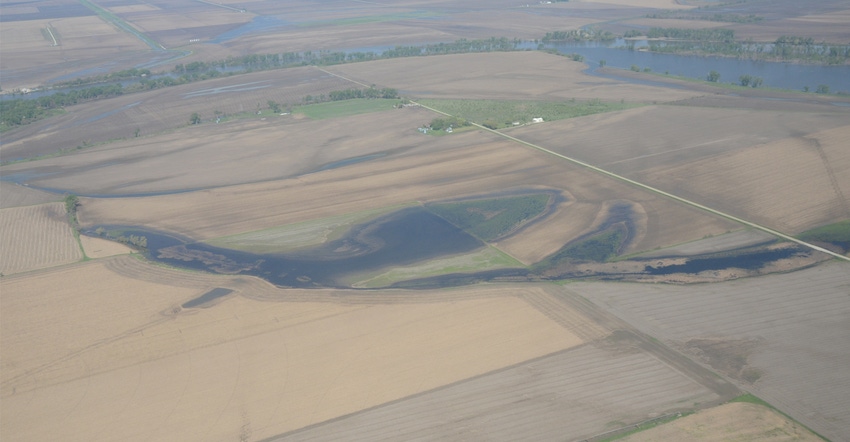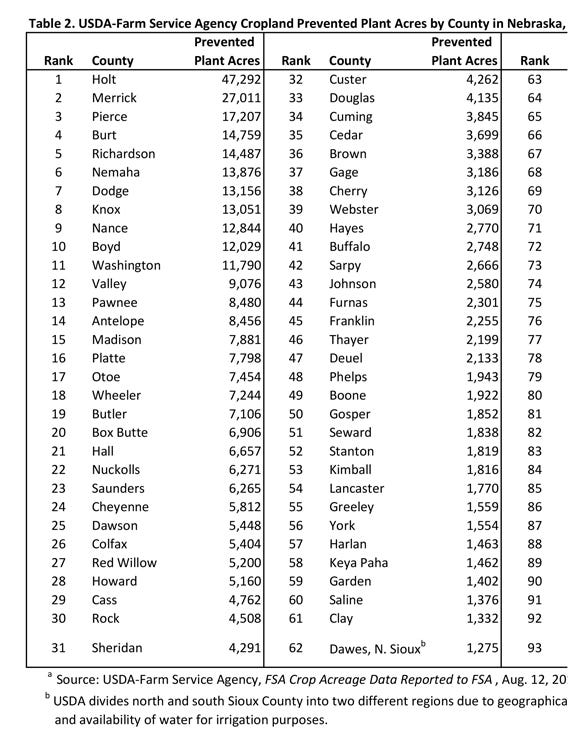August 28, 2019

By Jim Jansen and Jeff Stokes
Crop producers across Nebraska reported more than 400,000 acres of prevented plant land in 2019, according to data recently published by the USDA.
In total, the USDA reported more than 19.3 million acres of prevented plant cropland across the U.S. for the current growing season. Nationally, Nebraska ranked 16th among states with prevented plant acres (see Table 1 below).
South Dakota, Illinois, Ohio, Missouri and Arkansas accounted for about half of the prevented plant land in the U.S. with about 9.5 million acres. South Dakota led the U.S. with about 3.8 million acres, more than twice that of any other state.
Corn, soybeans and wheat were the top three prevented plant crops, accounting for 17.7 million acres. Traditional grain belt regions reported the largest share of prevented plant acres in the U.S.
Prevented plant acres in Nebraska
As of Aug. 1, the USDA Farm Service Agency reported 417,125 acres of prevented plant land in Nebraska, 407,522 of which would have been planted to the state’s major row crops (see Tables 1 and 2). Eleven of Nebraska’s 93 counties reported more than 11,000 acres each of prevented plant.

Holt County accounted for 47,292 acres, or more than 10%, of the state’s total. Areas of northeast Nebraska, including Holt County, had an unusually wet fall followed by a series of heavy spring rains that didn’t allow for fieldwork.
From Oct. 1 to Aug. 15, O'Neill, Neb., had 33.35 inches of precipitation, according to the High Plains Regional Climate Center. This compares to a 30-year normal (1981-2010) of 21.40 inches. Atkinson, Neb., had 29.42 inches of precipitation, compared to a normal of 20.82 inches.
The top five Nebraska counties with prevented plant acres are Holt with 47,292 acres; Merrick with 27,011 acres; Pierce with 17,207 acres; Burt with 14,759 acres; and Richardson with 14,487 acres (see Table 2 below).
The number of prevented planted acres across the state varied, depending on a county’s location. A considerable amount of prevented planted acres occurred in counties that bordered or incorporated streams, rivers or other bodies of water.
These areas included counties along the northern and eastern tier of the state bordering the Niobrara and Missouri rivers between Nebraska, Iowa and Missouri. Roads, bridges and municipalities also suffered excessive damages in these counties, as well as across Nebraska.

Considerations for producers
Producers facing prevented plant or failed cropland acreages need to maintain good communication on disaster-related issues with their crop insurance agent and local USDA FSA service center.
Also, other federal, state or local authorities may need to be informed. Maintaining direct lines of communication with the appropriate government entity or insurance company ensures producers understand their rights and responsibilities on properties affected by a natural disaster.
Jansen is a Nebraska Extension agricultural systems economics educator. Stokes is a University of Nebraska-Lincoln professor and Hanson-Clegg-Allen chair in agricultural banking and finance.
Source: UNL CropWatch, which is solely responsible for the information provided and is wholly owned by the source. Informa Business Media and all its subsidiaries are not responsible for any of the content contained in this information asset.
You May Also Like




